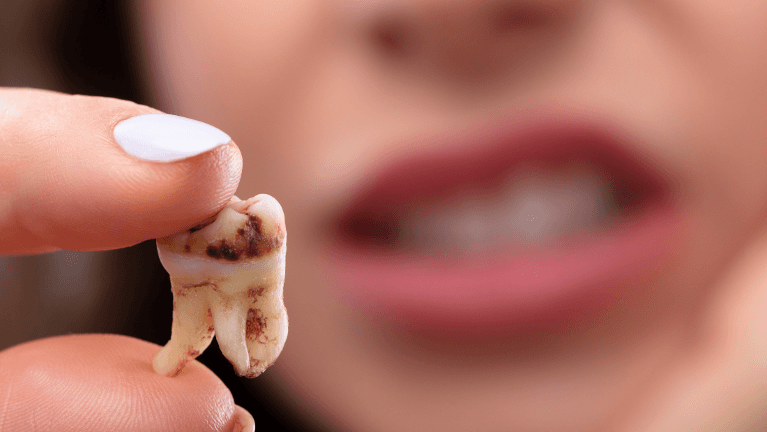
Tooth decay, often perceived merely as a common dental issue, represents a complex and evolving challenge in oral health care. From the initial stages of enamel demineralization to the critical phase of abscess formation, allow our dentist in Tarzana to elaborate on each step of decay presents unique signs and demands specific treatments.
So, What is Tooth Decay?
Tooth decay is the destruction of the hard tissues of the teeth caused by the buildup of plaque and harmful bacteria. If left untreated, this process can lead to cavities, infections, and even tooth loss. Factors contributing to tooth decay include poor oral hygiene, consumption of sugary and acidic foods, as well as poor lifestyle habits.
What Causes Tooth Decay?
The primary cause of tooth decay is the formation of plaque, a sticky film of bacteria that constantly forms on your teeth. When you consume food and drinks high in sugars and starches, the bacteria in plaque produce acids that attack tooth enamel. Over time, these attacks can lead to the demineralization of the enamel, progressing into more severe stages of decay.
The Five Stages of Tooth Decay
Understanding the progression of tooth decay is crucial in preventing and allows our Encino dentist to treat dental issues effectively. Here are the signs, consequences, and treatments at each phase to improve or maintain optimal oral health.
- Stage One: Initial Demineralization
The first stage is marked by white or brown spots on the enamel, indicating the loss of minerals. These spots often appear where plaque has been allowed to accumulate, such as near the gum line or in between teeth. At this early stage, the damage is still reversible with fluoride treatments, which can help remineralize the enamel and improve oral hygiene practices, including regular brushing and flossing.
- Stage Two: Enamel Decay
As decay progresses, the enamel starts to break down, forming a cavity. This stage is typically accompanied by minor sensitivity to sweets and temperatures. Regular dental checkups are crucial for early detection and treatment, which may include fillings or crowns to restore the tooth's structure and prevent further decay.
- Stage Three: Dentin Decay
Once decay reaches the dentin, the tooth becomes sensitive to temperature and touch due to the increased exposure of the dentin compared to the enamel. The dentin also decays faster than enamel, meaning treatment at this stage is more urgent. It often involves more extensive procedures to remove decay and restore the tooth's integrity using fillings, inlays, or onlays.
- Stage Four: Involvement of the Pulp
The most severe stage occurs when bacteria infect the pulp, causing inflammation and often intense pain. This infection can lead to the death of the nerve, resulting in an abscess. Some swelling and pain can also occur at this stage. Root canal therapy is often necessary for treatment, involving the removal of the infected pulp, cleaning and disinfecting the inner chambers, and sealing them to prevent further infection.
- Stage Five: Abscess Formation
In the final stage, a dental abscess forms, characterized by severe pain, swelling, and potential spread of infection to other parts of the body. The abscess is a collection of pus caused by the bacterial infection. It may require surgical intervention in addition to antibiotic treatment. Immediate dental treatment is necessary to alleviate pain, treat the infection, and preserve the tooth if possible, or extract it if necessary to prevent further health complications.
How Can You Tell If You Have Tooth Decay?
Detecting tooth decay in its early stages can be challenging, as the initial signs are often subtle and may not cause any discomfort. Key indicators to watch for include the appearance of white or brown spots on your teeth, which signal enamel demineralization. These spots indicate that the tooth enamel is starting to break down. Additionally, as decay progresses, you might notice small cavities or holes in your teeth, mainly where food tends to get trapped.
Another common symptom of advancing tooth decay is sensitivity to hot, cold, or sweet foods and drinks. This sensitivity indicates that the decay may have reached the dentin layer beneath the enamel, which is more sensitive. Persistent bad breath and an unpleasant taste in the mouth can be caused by the bacteria involved in the decay process. It's crucial to visit a dentist promptly for a thorough examination if you experience any of these symptoms. Regular dental checkups are also important, as dentists can often spot decay early on, often before you notice any symptoms.
How Can You Prevent Tooth Decay?
Preventing tooth decay involves a combination of regular dental visits, proper oral hygiene, and lifestyle adjustments. Brushing twice daily, flossing regularly, and reducing sugary snacks can significantly lower your risk of decay. Additionally, professional cleanings and fluoride treatments play a vital role in maintaining your oral health.
Your Smile, Our Expert Care
Remember, tooth decay doesn't happen overnight, but prevention starts today. At Nargiz I. Zadeh, DMD, we're dedicated to helping the Encino and Tarzana communities maintain their oral health. Our team is equipped with the knowledge, skills, and technology to detect early signs of decay and provide effective treatments. Schedule your appointment with us today, and let's work together to keep your smile pain-free and happy!